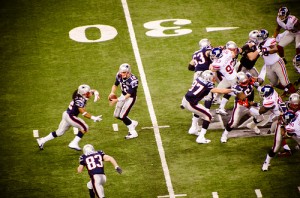(Almost) The Triumph of Game Theory at the Super Bowl
One of the amazing things about the Super Bowl game this past weekend was that both coaches understood that the Patriots would be better off if the Giants scored a touchdown late in the game and reportedly instructed their teams accordingly. To my mind, this represents a high point in the prevalence of strategic thinking.
Was the failure of Ahmad Bradshaw to follow through on his coach’s instruction merely a failure of execution?
But I wonder whether the Giants failed to strategically optimize on the very next play selection. With about a minute left in the game (and with a timeout remaining for the Patriots), the Giants choose to go for a two-point conversion. My question is not about whether they should have kicked a point after. No, I wonder whether they might have done better by handing the ball to a swift runner, who might have even more perversely attempted to forgo scoring two points and instead tried to burn as many seconds off the clock as possible by merely running away from the other team (toward, but not into, the other endzone!).
Here’s a strategic way to approach the question. If you were the Giants, which would you prefer:
- A six-point lead — and kicking to the Patriots with 60 seconds remaining, or
- A four-point lead — and kicking to the Patriots with 60 – N seconds remaining
What would be the “N” that would make you indifferent between these two outcomes? What would be the “N” that would make you indifferent, taking into account that two-point conversions are only successful about half the time?
There has to be some “N” at which the four-point lead is preferable.
So, how many seconds might a running back, who cared nothing about losing yards or scoring, be able to burn off the clock before being tackled? Where should a running back run to avoid being tackled? I would imagine he’d want to make liberal use of the immense area behind him. The coach might also want to send some other blockers running in the “wrong” direction to intercept the first wave of defenders who catch on.
Of course, before pulling the trigger, a coach would need to take into account the risk that the running back would fumble the ball and allow the Patriots to score. But if it’s possible to burn 15 seconds through such shenanigans, it might have been another perverse strategy worth considering.
It might be interesting for a high school coach to try the strategy in practice and see how long a running back could play keep away.
So Freakonomics nation, what say you? How many seconds would “N” need to be before a coach should be indifferent between the two strategies? And how many seconds do you think this evasive maneuvers strategy might be expected to burn off the clock?
Update: Thanks for letting me know that the clock doesn’t run during a two-point conversion. I stand corrected. There are other game situations, though, where the “keep-away” strategy might still be valuable. Your team has the ball, and it’s 4th and goal on the opponent’s seven yard line. Your team has a four point lead, and there are 12 seconds to go in the game. Do you want your team to *a) kick the field goal and go up by 7 and then kick off; or (b) play keep-away to use the remaining time by running to your own endzone and allowing yourself to be ultimately tackled for a safety?


Comments